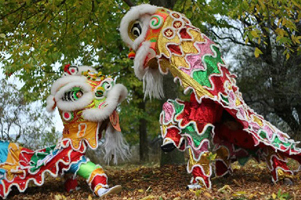Search for:
ARTISTIC
CONTRIBUTIONS
> Dance > East
Asian
Hong Luck Kung Fu Club |
Toronto's Hong Luck
Kung Fu Club was established in 1961 by Sifu Paul Chan. One of
the first Chinese martial arts schools in Canada, it has proudly
taught people of all cultural backgrounds since its early days.
It is a non-profit organization and its mission statement reads:
"To showcase and
preserve the beauty of
Chinese martial arts in Canada.
To pass on the knowledge of traditional kung fu.
To provide quality instruction."
Located in the Spadina/Dundas
Chinatown, the club has grown from an initial 20 associates to
well over 1,000 members. Sifu Chan and his students continue
to practice the Choi Lee Fut and Do Pi systems of traditional
kung fu, and the curriculum also includes Hei Gong (energy training),
San Shou (sparring), and Lion Dance. The club's sustained philanthropic
and community involvement has brought martial arts and Lion Dance
performances to many events over the years. From charity fundraisers
to private parties and from multicultural celebrations to Chinese-Canadian
festivals, Hong Luck has established a legacy of excitement through
spectacular displays of ancient traditions.
 The
Lion Dance, in particular, is both an important, celebrated symbol
of Chinese culture and Hong Luck's public image; traditionally,
the lion is said to represent the spirit of a kung fu club. Hong
Luck's lion dancers may be seen parading down local streets on
such occasions as Chinese New Year and the club's anniversary
but members of the Chinese community also contract them for functions
such as weddings, anniversaries and store openings. In these
types of events, there is a symbolic function attributed to the
Lion Dance, a function that differentiates them from performances
geared purely towards entertainment. Traditionally, the fearsome
aspect of the lion and the loud, raucous music of its accompanying
drum, gong and cymbals were thought to drive away evil spirits
and bring good luck.
The
Lion Dance, in particular, is both an important, celebrated symbol
of Chinese culture and Hong Luck's public image; traditionally,
the lion is said to represent the spirit of a kung fu club. Hong
Luck's lion dancers may be seen parading down local streets on
such occasions as Chinese New Year and the club's anniversary
but members of the Chinese community also contract them for functions
such as weddings, anniversaries and store openings. In these
types of events, there is a symbolic function attributed to the
Lion Dance, a function that differentiates them from performances
geared purely towards entertainment. Traditionally, the fearsome
aspect of the lion and the loud, raucous music of its accompanying
drum, gong and cymbals were thought to drive away evil spirits
and bring good luck.
In modern times, the literal
belief in old superstitions may have been attenuated but the
Lion Dance remains an important and auspicious ritual requiring
some very specific protocols and etiquette. Before and after
dancing, the lion must perform three bows as a sign of respect
for its audience. Should the dance occur in a place with an altar,
a further nine bows are required in front of it to honour ancestral
traditions. Another important feature of traditional Lion Dancing
is the eating of a green vegetable and the subsequent spitting
back of the broken up leaves. The words for 'green' and 'money'
sound similar in Chinese and so the action suggests spreading
good fortune.
Real lions never existed in
China but records of Lion Dancing date back to the Tang Dynasty
(CE 618-907). The style practised at Hong Luck is the symbolic
Southern Lion (as compared to the theatrical Northern Lion) and
features a fanciful head complete with a horn adorned with a
red ribbon, forehead mirror, and movable eyes, ears and mouth.
A sort of cape extends from the head and forms the body of the
lion by draping over a second dancer. The person playing the
tail is mostly bent over and follows the person playing the head
but may also be called on to lift up their partner. Lions come
in a three main colour schemes, each associated with a hero from
Chinese legend and symbolizing their characteristics: wise, old
General Liu Bei (gold and multicoloured); virtuous and noble
General Kwan Kung (red and black); and strong, brave General
Chang Fei (black, green, and white).
contributed by Colin McGuire
<<
top
The project was made
possible with the support of the
Department
of Canadian Heritage through the Canadian Culture Online Strategy
The Acrobat Reader
is available free from 